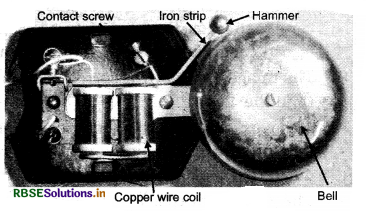RBSE Class 7 Science Important Questions Chapter 14 Electric Current and its Effects
Rajasthan Board RBSE Class 7 Science Important Questions Chapter 14 Electric Current and its Effects Important Questions and Answers.
RBSE Class 7 Science Chapter 14 Important Questions Electric Current and its Effects
Multiple Choice Questions
Question 1.
Which one of the following is not a part of an electric circuit?
(a) Cell
(b) Bulb
(c) Switch
(d) Current
Answer:
(d) Current
Question 2.
Pick the odd one out:
(a) Telephone
(b) Loudspeaker
(c) Electric bell
(d) Room heater
Answer:
(d) Room heater

Question 3.
What is the shape of the magnet in an electric bell?
(a) Cylindrical
(b) Bar
(c) Horse shoe
(d) Square
Answer:
(c) Horseshoe
Question 4.
Who discovered the deflection of a compass needle every time when the current was passed through a wire?
(a) Edison
(b) Oersted
(c) Galileo
(d) None of these
Answer:
(b) Oersted
Question 5.
Heat is produced in a wire when an electric current is passed through it this is due to :
(a) coils
(b) resistance
(c) magnetic effects
(d) none of these
Answer:
(b) resistance
Question 6.
In a battery the positive terminal of a cell is connected to this terminal of the next cell:
(a) positive
(b) negative
(c) both
(d) none of these
Answer:
(b) negative
Fill in the blanks
Question 1.
Connecting too many devices in one socket will cause................
Answer:
overloading
Question 2.
Only................marked appliances or fuse should be used.
Answer:
ISI
Question 3.
The shorter line is the symbol of the electric cell represents................terminal.
Answer:
negative
Question 4.
An electric circuit can be represented through a................
Answer:
circuit diagram
Question 5.
Greater is the resistance of a wire,................will be the heat produced in it. by a given current.
Answer:
greater
State Whether True or False
Question 1.
A nichrome wire offers high resistance.
Answer:
True
Question 2.
An electromagnet is a permanent magnet.
Answer:
False
Question 3.
An electromagnet is used in the electric bell.
Answer:
True
Question 4.
Iron does not get attracted to an electromagnet.
Answer:
False
Question 5.
The filament is made up of conducting wire.
Answer:
False

Match the following
|
Column I |
Column II |
|
Electric bulb |
(a) to take out magnetic scrap |
|
Electric iron |
(b) Maglev |
|
Fuse |
(c) Electric cell |
|
Electric bell |
(d) Heating effect |
|
Electric train |
(e) Nichrome |
|
Electromagnetic crane |
(f) Filament |
|
Electric battery |
(g) Safety device |
|
Electric heater |
(h) Gong |
|
CFL |
(i) Invention of magnetic effect |
|
Oersted |
(j) Reduced wastage of electricity |
Answer:
|
Column I |
Column II |
|
Electric bulb |
(f) Filament |
|
Electric iron |
(d) Heating effect |
|
Fuse |
(g) Safety device |
|
Electric bell |
(h) Gong |
|
Electric train |
(b) Maglev |
|
Electromagnetic crane |
(a) to take out magnetic scrap |
|
Electric battery |
(c) Electric cell |
|
Electric heater |
(e) Nichrome |
|
CFL |
(j) Reduced wastage of electricity |
|
Oersted |
(i) Invention of magnetic effect |
Very Short Answer Type Questions
Question 1.
What do the long line and the shorter line in an electric cell represent?
Answer:
The longer line represents the positive terminal and the thicker, shorter line represents the negative terminal.
Question 2.
How can you place the cells correctly in the battery compartment?
Answer:
+and–symbols are usually printed in the battery compartments so that we can place the cells correctly.
Question 3.
Where can we place the key or switch in the electric circuit?
Answer:
We can place the key or switch anywhere in the circuit.
Question 4.
What is the thin wire inside the bulb known as? What is it made up of?
Answer:
The thin wire inside the bulb is known as filament. It is made up of tungsten.
Question 5.
What is the basic feature of the filament of the bulb?
Answer:
The filament inside the bulb has a low melting point so that it melts on the passage of a high current.
Question 6.
If the filament of the bulb is broken, would the circuit be complete? Would the bulb still glow?
Answer:
If the filament of the bulb is broken, the circuit will be incomplete and open thus, the bulb will not glow.
Question 7.
Should you touch a lighted electric bulb connected to mains?
Answer:
No, we should never touch a lighted electric bulb connected to mains because it may be very hot and the hands may bum badly.
Question 8.
What is the coil of wire in electric devices known as?
Answer:
The coil of wire in electric devices is known as an element.
Question 9.
What happens to the electric heater/ electric iron after switching on the electric supply?
Answer:
After switching on the electric supply, the element becomes red hot and produces heat.
Question 10.
On what factors the amount of heat produced in a wire depends?
Answer:
Material, length, and thickness of the wire.
Question 11.
Why electric bulb is not desirable?
Answer:
An electric bulb used for light also gives heat. This results in the wastage of electricity thus, it is not desirable.

Question 12.
How can you reduce the wastage due to an electric bulb?
Answer:
We can reduce the wastage due to the electric bulbs by replacing it with CFLs (compact fluorescent lamps).
Question 13.
Where does the needle of the compass point?
Answer:
The needle of the compass points in the North-South direction.
Question 14.
What happens when we bring a magnet close to the compass?
Answer:
The needle of the compass shows deflection when we bring a magnet dose to it.
Question 15.
Name the scientist who noticed the magnetic effect of electric current for the first time.
Answer:
Hans Christian Oersted.
Question 16.
Place a small compass needle inside a matchbox. Connect the free ends of the wire to an electric cell and a switch. What will you observe on moving the switch to the ‘ON5 position?
Answer:
The compass needle shows deflection on the passage of an electric current.
Question 17.
When the electromagnet inside the electric bell pulls the iron strip it breaks the circuit. Will the coil still behave as an electromagnet?
Answer:
The coil is no longer an electromagnet when the electric circuit is broken.
Short Answer Type Questions
Question 1.
What are the conditions necessary for an electric current to flow?
Answer:
The necessary conditions for an electric current to flow are as follows :
→A source of electric current (a cell or a battery).
→A conducting material or metal wire.
→An uninterrupted path for the flow of charge.
Question 2.
Sometimes the cells are placed side by side in electric devices. Then how are the terminals of the cell connected?
Answer:
There is a thick wire or a metal strip inside the battery compartment of any device connecting the positive terminal of one cell to the negative terminal of the next cell. Thus, the terminals of the cell are connected side by side in the electric devices.

Question 3.
How can we connect the cells to prepare batteries for our activities?
Answer:
We can prepare a cell holder using a wooden block, two iron strips, and rubber bands to hold metal strips tightly. We can also buy cell holders from the market for making batteries of two or more electric cells.
Question 4.
Draw the circuit diagram for the above-given figure.
Answer:
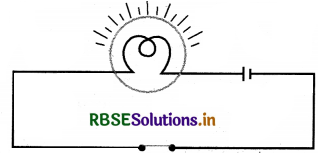
Question 5.
Why do we generally represent an electric circuit by its circuit diagram?
Answer:
We generally represent an electric circuit by its circuit diagram because it is much easier to draw circuit diagrams using symbols.
Question 6.
What are the possible reasons for excessive currents?
Answer:
The possible reasons for excessive current are as follows :
Short-circuiting:
Direct touching of wire may lead to excessive current in electrical circuits. This may happen due to the wear and tear of the insulation of wires.
Overloading :
The connection of many devices to a single socket may cause overloading in the circuit and thus may lead to possible fires:
Question 7.
What do you understand by the magnetic effect of electric current?
Answer:
When electric current passes through a wire, it behaves like a magnet. This is the magnetic effect of electric current.

Question 8.
Is electromagnet temporary or permanent?
Answer:
An electromagnet is temporary, the magnetism of the iron rod disappears as soon as the current through the coil is switched off.
Question 9.
On what does the strength of an electromagnet depend upon?
Answer:
The strength of an electromagnet depends upon the amount of current flowing through the coil and the number of turns of copper wire in the coil.
Long Answer Type Questions
Question 1.
What is the difference between an open circuit and a closed circuit?
Answer:
Difference between open circuit and closed circuit:
Open circuit:
When the switch is in the OFF position, the circuit is broken and currently does not flow through it. It is called an open circuit.

closed circuit:
When the switch is ON, the circuit is complete, and current flows through it. Such a circuit is called a closed circuit.
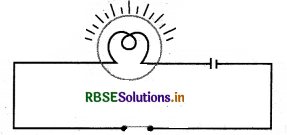
Question 2.
What is the basic requirement to connect two cells in the battery?
Answer:
The basic requirement is to connect the positive terminal of one cell to the negative terminal of the next cell.
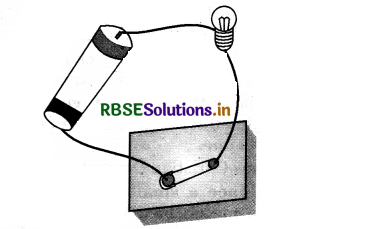
Question 3.
The wires used for making electric circuits do not normally become hot. On the other hand, the elements of some electric appliances become so hot and they are easily visible. Why?
Answer:
The wires used for making electric circuit are made up of conducting material that does not offer any resistance to the flow of an electric current whereas the element in an electric appliance is made up of nichrome which offers resistance to the passage of the current thus causing heating effect.

Question 4.
What are electric fuses? Why are they called safety devices?
Answer:
The wires made up of special materials which melt quickly and break when large electric currents are passed through them are known as electric fuses. There is a maximum limit of electric current that can safely flow through a circuit. If by accident the current exceeds this safe limit, the wires may become overheated and may cause a fire. If a proper fuse is there in the circuit, it may blow off and break the circuit, thus preventing damage to electric circuits and possible fires. Thus, electric fuses are called safety devices.
Question 5.
What is MCB? Why are they increasingly being used in place of fuses?
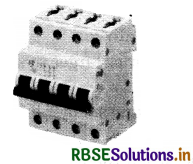
Answer:
MCBs are miniature circuit breakers, they are increasingly being used in place of fuses because MCBs are the switches that automatically trip down when the current exceeds the prescribed maximum limit. Thus, it prevents damage or fire. An electric fuse wire has to be replaced once broken due to the passage of high current whereas, MCB can be turned on and the circuit will be completed once again.
Question 6.
Write various uses of the electromagnet.
Answer:
Various uses of the electromagnet are as follows :
- It is used in separating magnetic materials such as iron, nickel, and cobalt from the garbage heaps.
- It is used in making appliances such as electric bills, telephones, audio players, and recorders.
- It is used in taking out tiny pieces of magnetic material that have accidentally fallen in the eye.
- It is used in various toys.
Question 7.
Explain the working of an electric bell.
Answer:
An electric bell consists of a coil of wire wrapped in an iron piece. It is connected to the source of current through a switch. It has a metallic gong, a hammer to strike the gong, and a contact screw attached to the iron strip. When the iron strip is in contact with the screw, the current flows through the coil which becomes an electromagnet. It pulls the iron strip, in this process the hammer at the end of the strip strikes the gong of the bell to produce a sound. But when the electromagnets, pull the iron strip, it also breaks the circuit.
The current through the coil stops flowing. The iron strip comes back to its original position and touches the contact screw. This completes the. circuit again and the process is repeated in quick succession and the bell rings.
